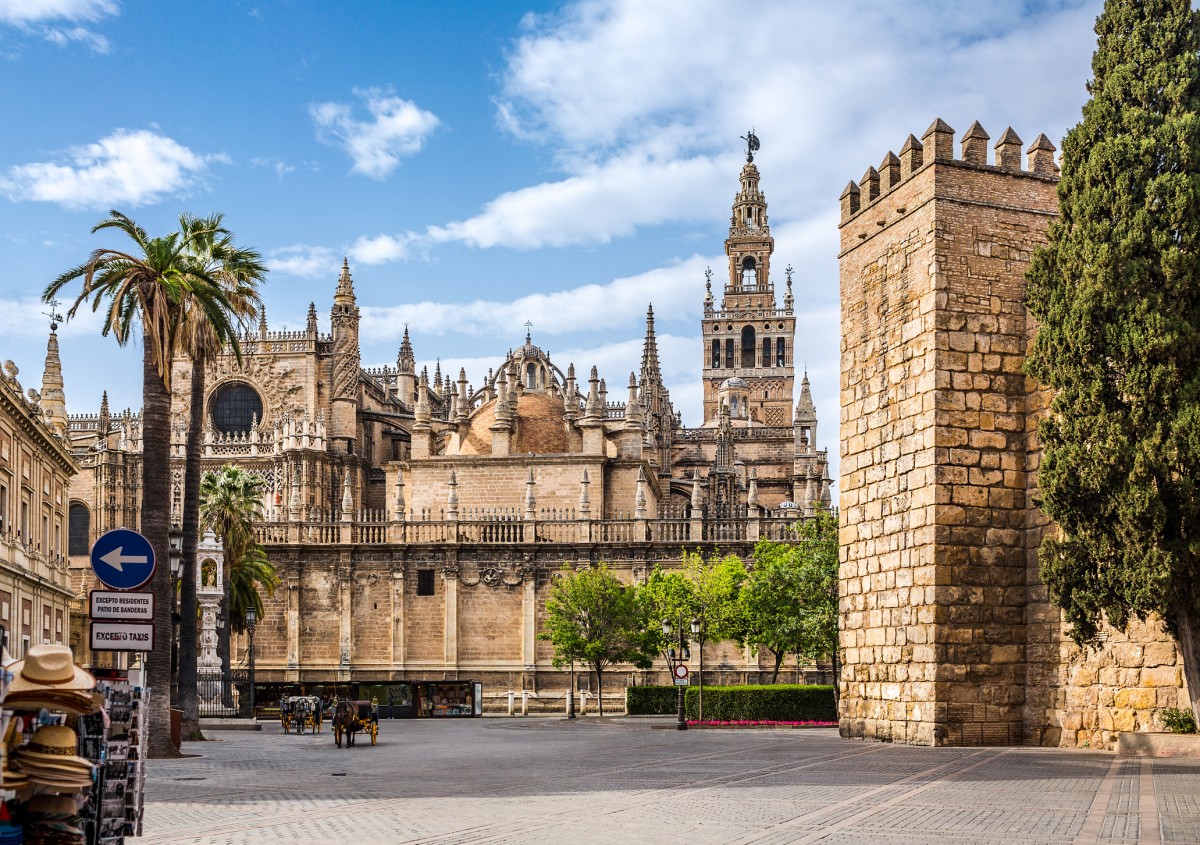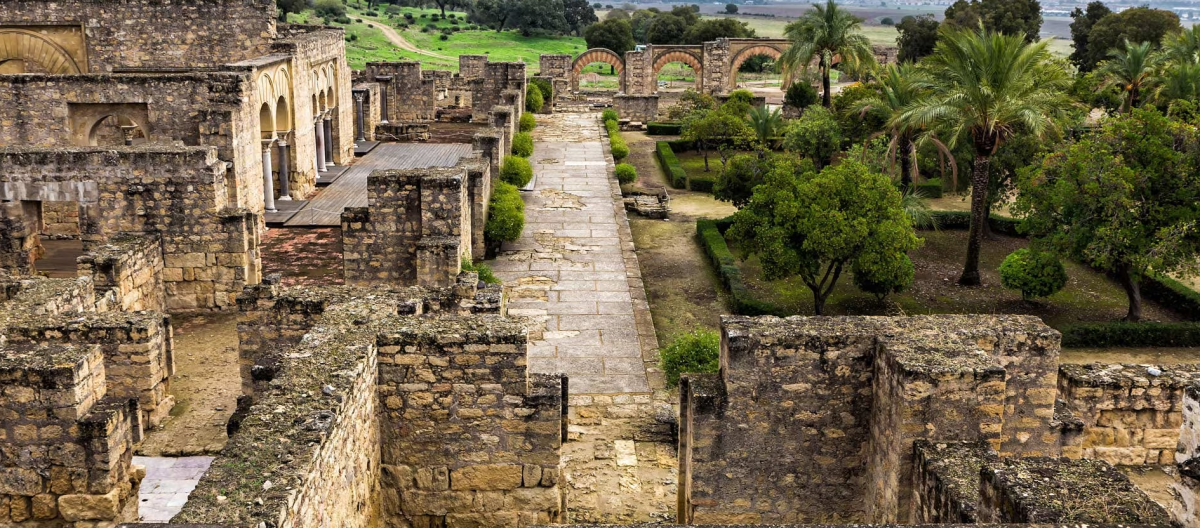
The Moors, along with the Romans, were the invading populations that exerted control, in one form or another, over Spain for the longest period. The Iberian Peninsula was first conquered by the Romans in 218 BC, during the Second Punic War against Carthage, and was brought fully under Roman control in 19 BC, following Augustus's battles against the Cantabrians and Asturians. Spain remained under Roman control for nearly 600 years until around 409 AD, when various Germanic groups invaded the peninsula.
The Moorish invasion of the Iberian Peninsula began in April 711 AD, when Musa ibn Nusair, who was to become the first governor of al-Andalus, sent his freedman Tariq ibn Ziyad to command an army of some 9,000 Berbers to the Iberian Peninsula. According to various sources, the troops landed in Tarifa or on the promontory of Calpe, thus beginning the Muslim conquest of Hispania.
Alerted to the presence of invaders, the Visigothic king Rodrigo forced his way across the peninsula to meet the Moors in battle by the river Guadalete on 19 June 711 AD. Although the battle was closely fought, the brothers of the late King Witiza, Oppas (later Bishop of Seville) and Sisberto betrayed Rodrigo, thus ending the life of the last Visigothic king.
Most of the territory was quickly conquered by the Moors in the following years, although the north (especially the region of Asturias) remained outside Muslim control. The reason for this rapid conquest, according to many historians, is that several Visigothic nobles decided to make a pact with the invaders in exchange for retaining their privileges, a strategy that was also adopted by the Church.
Over the centuries, the northern Christian kingdoms began the Reconquista, a process of gradually reclaiming the territory. This process lasted almost 800 years, culminating in the capture of Granada in 1492 by the Catholic Monarchs, Isabella I of Castile and Ferdinand II of Aragon.
Traces of that bygone era remain and are well worth a visit for their rich history and breathtaking beauty. In this article, we have compiled some of the most remarkable Islamic ruins and monuments in Spain.
The Alhambra, Granada
One of the most impressive monuments left by Moorish culture is undoubtedly the Alhambra. Its name comes from the Arabic term ‘Al-Hamra’, meaning ‘The Red’, possibly due to the reddish hue of the fortress walls when illuminated by the sun. This hilltop palace city is the result of several stages of construction and alterations over centuries. However, its origin and most of its emblematic structures are attributed to the Nasrid dynasty (13th century), which ruled the Kingdom of Granada for two centuries.

This architectural site consists of a series of palaces, gardens and fortresses that reflect the richness and sophistication of Nasrid culture and Islamic art. Its walls and ceilings are adorned with intricate plasterwork, tile mosaics, and carvings, all of which are outstanding examples of the skill and creativity of the artisans of the time.
In 1984, the Alhambra was declared a UNESCO World Heritage Site, and today it is one of the most popular tourist destinations in Spain and the world. Its beauty, history, and cultural significance make it a timeless testament to the coming together of cultures on the Iberian Peninsula and the splendour of Europe’s Islamic past.
Some of the Alhambra's most outstanding sites are:
- Generalife: in the eastern part of the Alhambra, the Generalife was the summer palace of the Nasrid kings of Granada. Its name comes from the Arabic "Jannat al-Arif", meaning "Garden of the Architect".
- Nasrid Palaces: this palace complex was the residence of the Kings of Granada. It contains incredibly beautiful halls and courtyards, such as the Court of the Myrtles, the Chamber of the Ambassadors, the Alcazaba and the Court of the Lions.
- Palace of Charles V: although a Renaissance rather than a Nasrid building, its imposing façade and the circular courtyard inside make it a distinctive feature of the Alhambra complex.
Cordoba's Mosque-Cathedral
Cordoba’s Mosque-Cathedral is a monumental religious and historical building and a UNESCO World Heritage Site. It is the third-largest mosque in the world by surface area, behind those in Mecca and Medina, and the second-largest in Spain.

The mosque was built in the 8th century by Muslims. In the following centuries, it was enlarged and remodelled on several occasions, reaching its peak splendour in the 11th century during the Caliphate of Cordoba. It was later converted into a cathedral in the 13th century, after the reconquest of Córdoba by the Christians. In the 16th century, a Gothic choir was constructed in the centre of the prayer hall.
The building consists of two main areas: the porticoed courtyard, or sahn, and the prayer hall, or haram. The courtyard is surrounded by impressive horseshoe arches supported by columns of marble, granite, and jasper. The prayer hall features 856 columns of white and green marble supporting horseshoe arches. In the centre of the hall is the mihrab, a niche indicating the direction of Mecca.
Seville's Giralda Tower
Originally built in the 12th century as the minaret of the Great Mosque of Seville during the Almohad period, the Giralda reflects the city's rich historical and cultural heritage, where both Muslim and Christian civilisations have left an enduring mark. The 104.5-metre-high minaret is renowned for its architectural design, which combines elements of Almohad architecture with Renaissance and Baroque influences added after the Reconquista.

In 1248, following the Christian Reconquista of Seville by Ferdinand III, the Great Mosque was converted into a Christian cathedral, and the minaret was preserved. In the 16th century, a Renaissance bell tower was added to the top of the minaret, crowned by a weathervane in the form of a statue known as "El Giraldillo," which gives its name to the tower.
Calatrava la Vieja Castle
Calatrava la Vieja Castle is located in Carrión de Calatrava, in the province of Ciudad Real. Originally founded in the 8th century as a Muslim fortress, this structure has witnessed numerous conflicts and historical events over the centuries. The castle and its surrounding town became a strategic point due to its position between the Guadalquivir Valley and the Central Plateau, serving as a defensive frontier between Christian and Muslim territories during the Reconquista.

In the 13th century, after several battles and changes of control between Muslims and Christians, the Order of Calatrava, a military and religious order, took command of the castle and renamed it "Calatrava la Vieja" (Old Calatrava) to distinguish it from "Calatrava la Nueva" (New Calatrava), a nearby fortress. Over time, the site lost its strategic importance, and the surrounding settlement began to decline.
Zaragoza's Aljafería Palace
The Aljafería is a fortified palace in the heart of Zaragoza. Built in the 11th century during the period of the Taifa kingdoms, this architectural gem is one of the most outstanding examples of Hispanic Islamic art in northern Spain. Originally, the Aljafería served as the residence of the Hudi kings of the Taifa of Zaragoza and was later used by Christian monarchs after the Reconquista. Over the centuries, the palace has undergone numerous alterations and adaptations, reflecting the rich mix of cultures that made their mark on the region: Muslim, Jewish and Christian.

The Aljafería is renowned for its impressive interior courtyard, surrounded by horseshoe arches beautifully adorned with tiles and plasterwork, reflecting the grandeur of Mudejar art. After the Reconquista, in the 12th century, the Aljafería was adapted by the Christian Kings of Aragon, and during the time of the Catholic Monarchs, it was transformed into a fortified palace. Later, in the 18th century, it was used as military barracks. Despite these changes and adaptations, the Aljafería has retained elements of its original design. Since 1987, it has housed the Aragón Parliament.
Malaga's Alcazaba
Malaga's Alcazaba is a palatial fortification situated on the slopes of Mount Gibralfaro, in the historic centre of Malaga. It is one of the city's most emblematic monuments and one of the best-preserved Muslim fortresses in the country. Built between the 11th and 14th centuries, the Alcazaba served as a residence for the Muslim rulers of the region as well as a defensive fortress. The architectural complex is a blend of military structure, with its sturdy walls and towers, and the elegance and refinement of a palace.

The enclosure consists of two areas: the lower part, which is more military and defensive, and the upper part, which houses the palace along with its beautiful courtyards and gardens. The Alcazaba’s unique feature is its close relationship with the Gibralfaro Castle, another hilltop fortification, to which it is connected by a defensive passage known as the Coracha.
Medina Azahara, Cordoba
Medina Azahara is an Andalusian town on the outskirts of Cordoba in southern Spain. It was commissioned by Caliph Abderraman III in the 10th century as a symbol of his power and magnificence after he proclaimed himself Caliph of Al-Andalus. The town, whose name means ‘The Shining Town’, sprawled over a vast area and was intended to serve as the royal residence as well as the administrative and political centre of the caliphate.

However, the grandeur of Medina Azahara was short-lived. Despite the enormous investment in its construction, the city suffered looting and was partially destroyed during the civil war that led to the collapse of the Caliphate of Córdoba in the mid-11th century. For centuries, its ruins remained forgotten until they were rediscovered in the 19th century. Since then, excavations and restorations have unveiled a majestic site that was once the centre of power in the Islamic West. In 2018, Medina Azahara was declared a UNESCO World Heritage Site.
The Cristo de la Luz Mosque, Toledo
The Cristo de la Luz Mosque in Toledo, built in 999 as a small mosque, is one of the best-preserved examples of Muslim architecture in Spain. With an almost square floor plan and a distinctive apse, the structure is influenced by Visigothic architecture, showcasing the continuity and fusion of styles present in al-Andalus. Also noteworthy is its system of arches, which supported a wooden roof, and the mural decoration that adorns the interior, representing the Andalusian art of the period.

After the Reconquista of Toledo in 1085, the mosque was consecrated as a Christian church under the patronage of Cristo de la Luz (Christ of the Light). During this process of adaptation, an apse with Romanesque frescoes was added, making the building a unique example of the harmonious coexistence and juxtaposition of artistic and religious styles. Over the centuries, the Cristo de la Luz Mosque has undergone various alterations and restorations but has retained much of its original character.
The Alcazar of Seville
Seville's Alcázar Palace is one of the oldest palaces in use in the world and is a shining example of the confluence of cultures in Andalusia. Located in the heart of Seville, this impressive palace complex has, over the centuries, been a central figure in Spain's rich history, influenced by diverse cultures, from the Romans and Visigoths to the Almohads and Christian monarchs. The most prominent architectural influences are Islamic and Mudejar, evident in its intricate plasterwork, tiles, and ornate courtyards reminiscent of the Alhambra style. However, it also incorporates Gothic, Renaissance, and Baroque elements, reflecting the successive stages of construction and renovation.

After the Reconquista of 1248 by Ferdinand III of Castile, the Alcázar was transformed into a Christian royal palace. One of its most emblematic features is the Patio de las Doncellas, with its central pond and arched galleries. The gardens, with their sprawling green areas, fountains, and pavilions, are another attraction that invites visitors to lose themselves in a journey through time and history. Over the years, the Alcázar has served as the residence of monarchs, the setting for historical events, and more recently, as a location for film productions. In 1987, it was declared a UNESCO World Heritage Site, solidifying its status as one of Spain's most significant and evocative monuments.